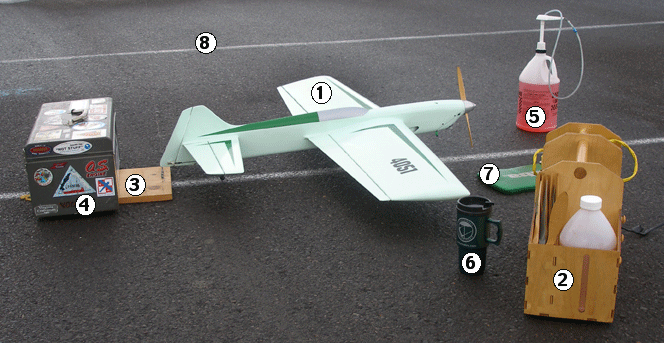

Modeling thought for the month:
"If at first you don't succeed, find out if the
loser gets anything."
-- Bill Lyon

It's unofficially winter, but that doesn't mean it's time to stop flying. In fact, some of the best flying days are in winter, when the air is calm, and the sun is nicely shaded behind a convenient overcast.
However, sometimes we find ourselves at the flying field all alone, as the other members of the local club can't tear themselves away from the warm armchair and the football game. So, every flyer needs a contingency for that nice winter flying day when he's out there all alone. Here's ye olde FL editor's "lonesome winter flying rig."
1. An old airplane you don't mind flying with the stooge, but one that's good enough to allow plenty of practice flights where you can get those bottoms down and aim at those intersections. Flying alone allows repeated flights, all in a row, where you can really dial in your skills. Ye editor's "beater" is an old Lite Wave, conveniently powered with an O.S. .35FP that's a one-flip starter, even in cold weather.
2. Your usual pitbox, including starter (see yellow cord) just in case the cold weather makes engines balky.
3. Stooge.
4. Heavy toolbox to hold the stooge down on the asphalt.
5. 15% nitro fuel (the beater plane's a little heavy, and likes that extra horsepower!).
6. Coffee mug (NW Skyraiders hi-tech version shown here).
7. Pad to keep knees dry.
8. Most of all, a field where you can fly year-round. And here's one more reason to keep flying all winter: You want to make sure your site owner knows it's being used, so he's not tempted to turn it into something other than a flying field.
So, get up off that couch and put together your own winter flying kit, and get out to your local field for some winter practice!
Winter's also (mainly) time for building, too. Here in the FL workshop we're doing some maintenance work, and also getting started with our next big project.
The maintenance work, among other things, involves completely refinishing the Vector 40 cowling, which got pretty fuel-soaked in two years of flying. It's in the painting stage now and is going to come out really good, I think.
What I did to salvage the cowling was to use acetone to strip off the dope down almost to bare wood, and then K2R, laquer thinner and more acetone to get as much of the grease out as possible. The I took the idea someone gave me earlier in the fall (darn, I can't remember who suggested this) and used cya glue to reseal the cowling. As luck would have it, I had a bottle of gap-filling cya that had gotten a little old and slow, which was perfect for the job. I could smear it on and wipe as much excess off as possible, and the fact that it was old gave me plenty of working time. Then a little sanding, clear, primer, silver ... almost back to new!
The "big project" is one that's just for fun. Can't be doing "serious" stuff all the time! I've started building a twin-engine stunter for P-40, This will be based on the Twin Flite Streak, using plans obtained from John Miller. My version will be slightly smaller than John's plans -- which call for a 72-inch wingspan! That won't fit too well in my pickup, at least not along with anything else, so I am reduding the wing by two rib bays (12%), and the elevator-stab by a like amount. It still will be a 63-inch-span behemoth, powered by two O.S. LA .15 engines. I've just started on the project, but hope to have it ready for next season's flying.
But enough about what's in the Flying Lines workshop. What's in yours?
Send us some info about your winter projects, along with a photo or two of the progress, and we'll come up with a winter projects page for the Flying Lines web site.
Also, don't forget to go through your archives and dig out some historical Northwest CL photos for our upcoming NW CL History page.
Remember, Flying Lines is your web site. Ye olde editor is just the mechanic putting it together. Send in your info and help spread the work about what's going on in Northwest CL flying to your fellow modelers!
This page was updated Nov. 4, 2006